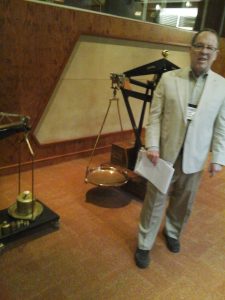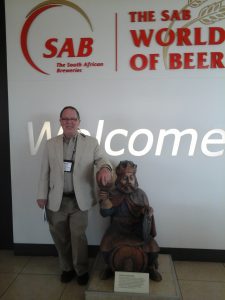
We went to Anglo Ashanti gold where someone told me I’m worth my weight in gold so I tried to get on the assayers balance.
Today is our last day in Johannesburg, and we’re leaving with a much better picture of “doing business in South Africa” especially after our two visits today, both to multinational corporations.
The first was to Anglo Ashanti Gold, the first South African company to be listed on the New York stock exchange, and the third largest gold mining company in the world. That seemed appropriate because more than half of the gold mined in history has come from South Africa. It seemed appropriate for another reason as well—the importance of mining in opening up Africa. The discovery of diamonds at Kimberly and the Witwatersrand gold in 1886 were drivers in the colonial expansion into the continent of South Africa. Johannesburg really owes its birth to the Gold Rush. And mining has become a major employer in South Africa, affecting housing, race relations, and South Africa’s place in the world.
The current company is fairly recent, having been born in a merger between Ashanti Goldfields and Anglo American. The professor leading the tour told me that the roots go back to a joint venture early in the 20th century between a South African named Oppenheimer and JP Morgan. That branch went off to become Anglo American, a company that deals with a variety of mining operations (copper and platinum, for example), while AngloAshanti is only as good as gold.
In fact, that was very much the tack our speaker took in explaining the company to us; it’s only as good as gold, and operates in a volatile environment that has had the price of gold plummet to under $900 from about $1600 in the last few years, and resulted in a major contraction in the industry; Anglo has cut over 10,000 jobs, and sold off a number of mines to reduce its financial exposure and reduce its debt. Like most gold mining companies, he said, Anglo had predicted the price of gold would never decline, and had purchased, explored, and expanded—hence the need to contract. He used the word “sustainability” in a rather unusual way—arguing that the company needed a “sustainable cash flow”!
He articulately laid out the risks in this industry—in addition to the usual ones all industries face, such as weather and currency fluctuations, but also the growing political risks of being in a dangerous and sometimes environmentally conscious world in an activist and connected world; he admitted he could only explain away as fate the deaths of two miners caught underground in an earthquake, but pointed out the company had made safety one of its goals, but closed with a quotation from Mark Twain: “Mines are dirty holes in the ground with a liar on top.” Small wonder that one of the messages over the urinals was, “You always have a choice—let our ethics be your guide.”
The business is inherently risky, and becoming riskier. Mines are increasingly deep he noted—some are over 2 miles underground, and it takes nearly four hours of an eight hour shift to get to and from work (even worse than a commute in rush hour Chicago!). Small wonder that the company is spending $50 million on developing a robotic gold extractor….especially with the tight connections between unions and the government of South Africa.
He painted, in others, an interesting picture of a company in a dangerous industry, with plummeting prices, focusing on efficiency and cost cutting, compensation for the days when good as gold was an optimistic phenomenon.
Our other visit was to South African Brewery, one of South Africa’s important industries, but soon to be purchased by the InBev Anheuser Busch company to create the world’s largest brewery; that may in itself cause some major reshuffling as the combination will create almost monopolistic power in some countries. SAB owns Miller in the US for example, and I read something about the probability one of the brands will have to be spun off. The company dates back to the 19thcentury, and became a fixture in Johannesburg after the gold rush. A few points during the presentation that interested me: 1) Miller owns the whole channel of distribution. In the US, post prohibition required independent wholesalers, such as city Beverage in Bloomington. Our speaker said, “That’s why AB isn’t as profitable as it could be.” 2) she emphasized (as did the video describing the company) “cold affordability”, due in large measure to the demographics—a growing middle class, but with a great deal of uncertainty in the home market. Growth is relatively flat, though South Africans don’t drink as much beer as most of the rest of the world. Growth is coming from premium and flavored beer (note to the wise, Chocolate Milk Stout beer isn’t as good as it sounds). 3) SAB has grown through acquisitions (such as Miller Coors), and also moved into non beer products, such as Coca-Cola.4) in response to my one word question, “AB InBev,” she was pretty optimistic about the synergies of new markets. I don’t think she’s read the St. Louis papers, which are still whining about the purchase of the All American lager by the “efficient” (read cost cutting) Brazilians who run the Belgian company.
We also learned a little more about apartheid and its consequences. Blacks could not legally drink until the 1960s, for example, but today, government policies rectifying the past include “transformation” of businesses to ownership by Africans. SAB distributorships, for example, are part of that transformation. We made a brief stop at the Museum of Africa—a large building no one seemed to know what to do or could afford to tear down; hence it has what can at best be described as an “eclectic” combination of displays that you really stumble on. One was a small Scouting exhibit, smaller than the Ottawa museum’s similar collection of Baden Powell artifacts. Another dealt with a question I had regarding Gandhi, who lived for almost 20 years in South Africa, about half the time in Johannesburg. It was here, the exhibit noted, that he began the practice of non-violent resistance that eventually toppled the Raj in India—here he led protests against the compulsory Asian Immigrant Act which required Asians to register and get passes.
And finally, we had a tour of downtown Johannesburg, which, except for government buildings, our guide described as a “ghost city.” He noted that whites owned the buildings before the end of apartheid, but abandoned it afterwards. It’s not totally abandoned, but once five star hotels are vacant, and most buildings have no more than shops on the first floor. Everything else is empty, with boarded up or broken windows. As our guide stated, people with money shop at the malls, like the posh Nelson Mandela mall across from our hotel. I saw a McDonald’s, a Burger King, and a Game (one of the Massmart stores) downtown, but mostly locally owned shops. There’s a lovely old post office building with broken windows surrounded by scaffolding, which our guide said had been in place for three years, with no progress.
On a more humorous closing note, I picked up a China Daily at the front desk (yes there is a China Daily African edition). I was drawn to an article on a Chinese agricultural mission in rural Ethiopia that complained about the toilets on the farm. They wound up getting a Chinese government grant for new toilets and additional TVs so they would have a better stay at the agricultural station. I hope my experience with the toilets will be better than the Chinese!



One Response to Last day in Johannesburg